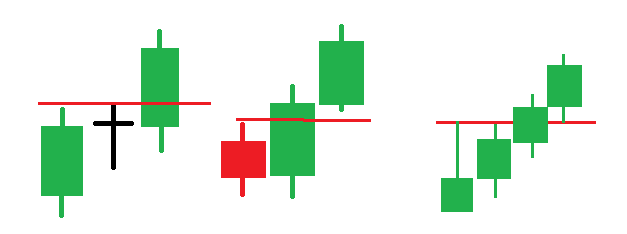Price Action Analysis in Trading
In this article, I will discuss Price Action Analysis in Trading. Please read our previous article, where we discussed Candlestick Analysis in Trading. As part of this article, we are going to discuss the following pointers in detail, which are related to Price Action Analysis in Trading.
- What is Price Action Analysis?
- Understanding the advanced features of CANDLESTICK
The ultimate guide you will ever need to understand CANDLESTICK and its characteristics. Once you complete this article, you will not need to recognize any CANDLESTICK patterns.
What is Price Action Analysis?
The Price Action Analysis is the movement of price in the chart. The candlestick format shows clear price action. I mean what buyers and sellers were doing during that period. Their activity clearly shows in CANDLESTICK. So, to learn price action, we have to learn all the basic and advanced features of candlestick
5 steps to candlestick analysis
Step1: The size of the body (high to low)
BODY:
- Narrow
- Average
- Wide
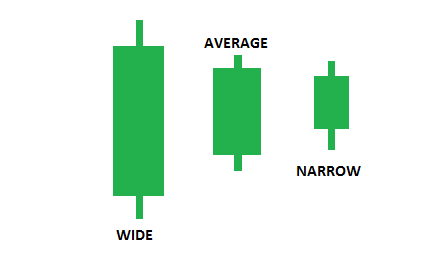
Find the body of your timeframe. The candle’s body shows a lot of information, such as
- A long body is showing strength
- A narrow body shows weakness
- When consecutive bodies become larger and larger, it shows an increase in momentum
- When consecutive bodies become smaller and smaller, it shows slowing momentum
- If an up or down move with greater than average body candle, it shows volatility high
How to compare?
- current candlestick with respect to the previous candle
- current candlestick with respect to the same swing
- current candlestick with respect to the previous swing
Step2: The length of the wick
- Larger wicks show that the price moved a lot during the candle’s duration, but it was rejected, which shows the presence of supply or demand.
- At major support and resistance levels. Candlewick becomes larger, which indicates volatility. This generally happens after long trending phases before a reversal happens from the support and resistance level.
- One more thing: the longer the shadow, the more likely prices will move in the opposite direction of the shadow
- Long-wick candles do not always signal a reversal. If a subsequent move engulfs the wick of the rejection candle, it fails; it is called reverse rejection.
- If it appears between the trend, it shows trend cont. ( as a small pullback in a smaller time frame)
- While a single long wick indicates possible prices moving in the opposite direction of the wick, a cluster of multiple wicks indicates that prices are likely to move in the same direction of the wick created, and if the body closes the direction of the trend
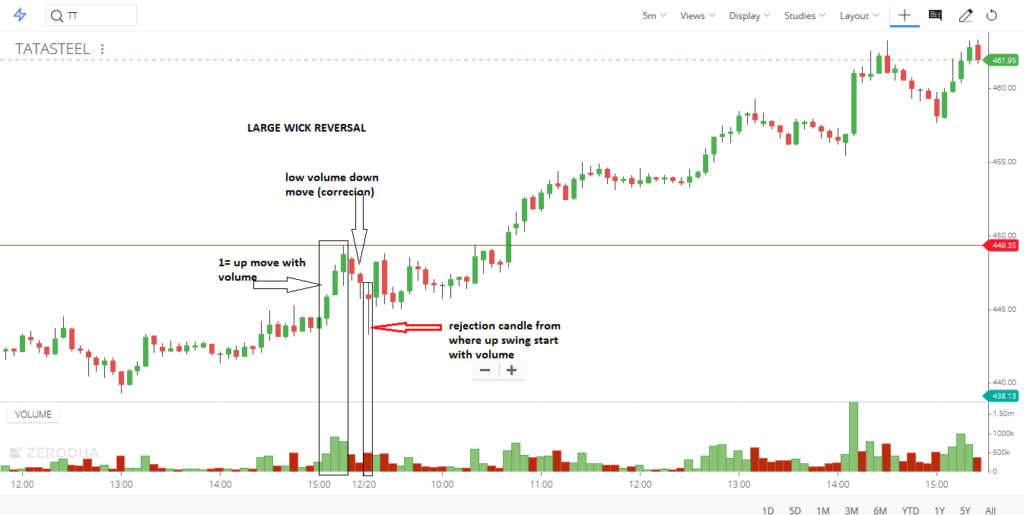
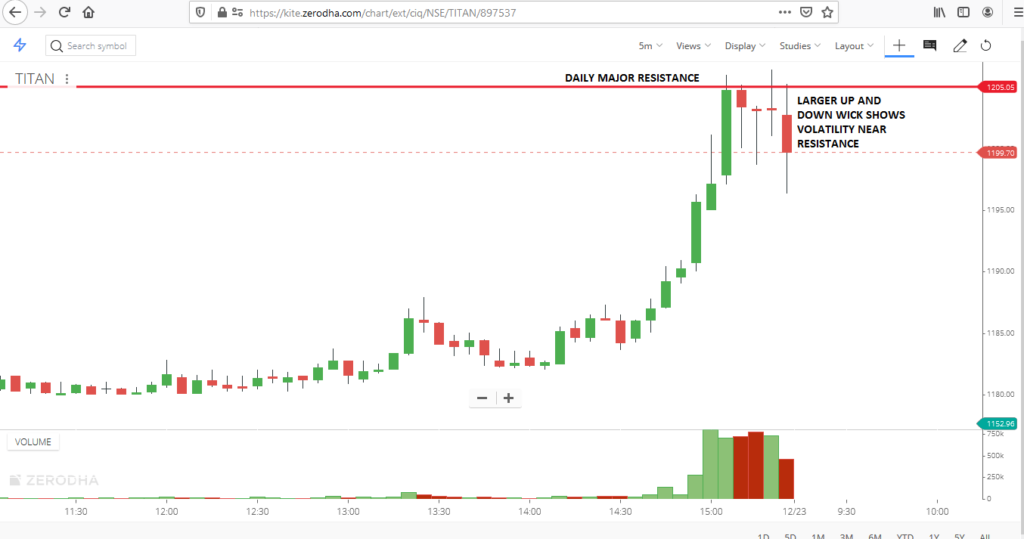
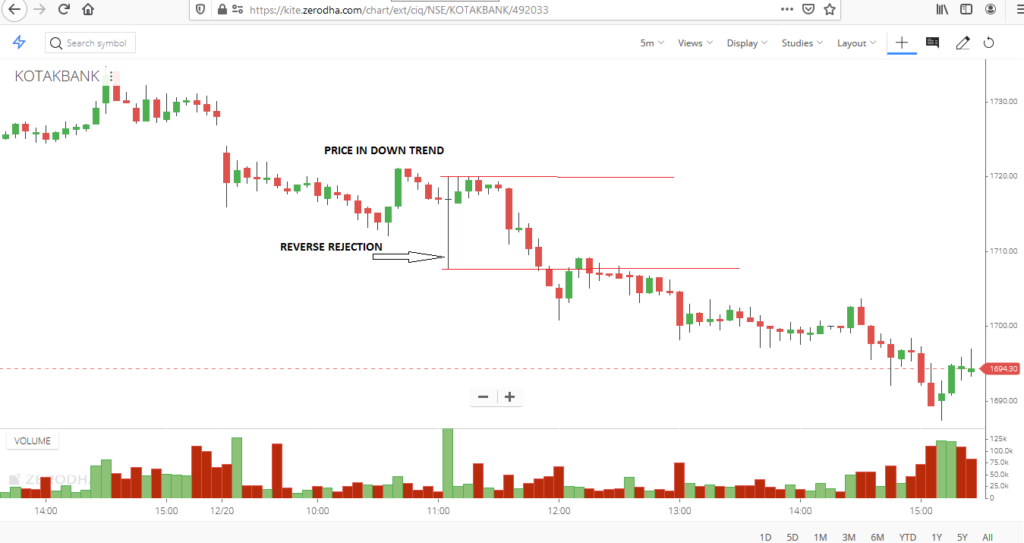
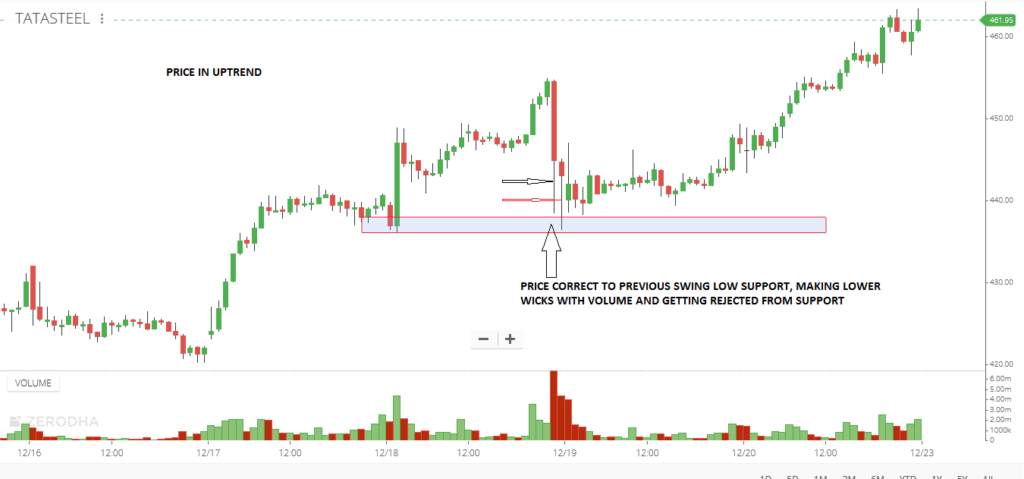
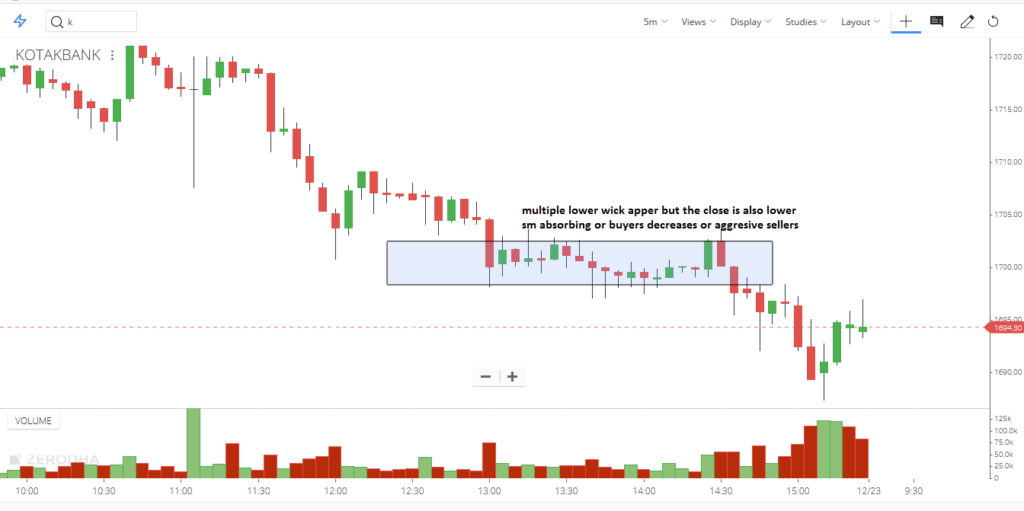
Step3: The ratio between wicks and bodies
Understanding the relationship between the open and close when compared to the high and the low of the present bar
- Open price tells us where the balance between buyers and sellers at the opening of that period is.
- Close price tells us where the balance point was at the end of the period

Etep4: Volume contains
WYCKOFF BASIC LAW
- THE LAW OF SUPPLY AND DEMAND: When demand is greater than supply, then the price will rise to meet this demand, and conversely, when supply is greater than demand, then the price will fall
- THE LAW OF CAUSE AND EFFECT: The effect will be indirectly proportional to the cause. In other words, a small amount of volume action will only result in a small amount of price action. If the cause is large, then the effect will be large, and vice versa.
- THE LAW OF EFFORT VS RESULT: Similar to Newton’s third law. Every action must have an equal and opposite reaction. In other words, the price action on the chart must reflect the volume action below. Effort (volume) is seen as the result (price), were validated, and anomaly comes into consider
Wide spared candle
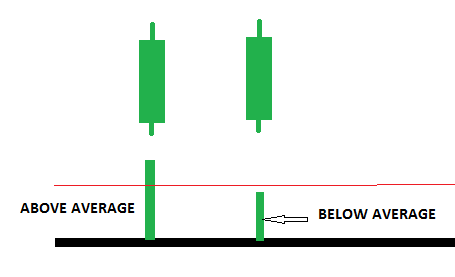
Price action –
There is strong bullish market sentiment. The price has risen sharply and closed at or near the high of an up candle.
Volume Action–
- Therefore, the associated volume should reflect this strong sentiment with a ‘strong’ volume. As we can see in the above example, if the volume is above average(effort vs. result), then this is what we should expect to see as it validates the price. Smart money is joining the move higher, and everything is as it should be.
- This is a warning signal if the volume is below average or low. The price is being marked higher but with little effort. The move is not genuine. If we are in a position, we look to exit. If we are not in a position, we stay out and wait for the next signal to see when and where the smart money is now taking this market.
Narrow Spread Candles
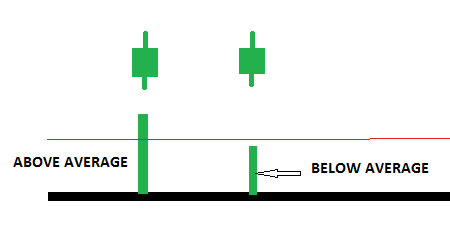
Price action – weak market sentiment
Volume Action–
- A narrow spread candle should have low volume – again, effort vs result.
- NARROW SPREAD CANDLE WITH HIGH VOLUME. If the volume had represented buying, how could the spread be narrow? Only two possible explanations exist for a narrow spread-up candle on a high volume.
- Either the professional money is selling into the buying [see the end of a rising market]
- There is a trading range to the left, and the professional money is prepared to absorb the selling from traders locked into this old trading range.
Step5: RELATIVE OR 2 CANDLE PRICE ACTION
DIRECTION OF CANDLE
The relationship of each bar’s high/low relative to the previous bar
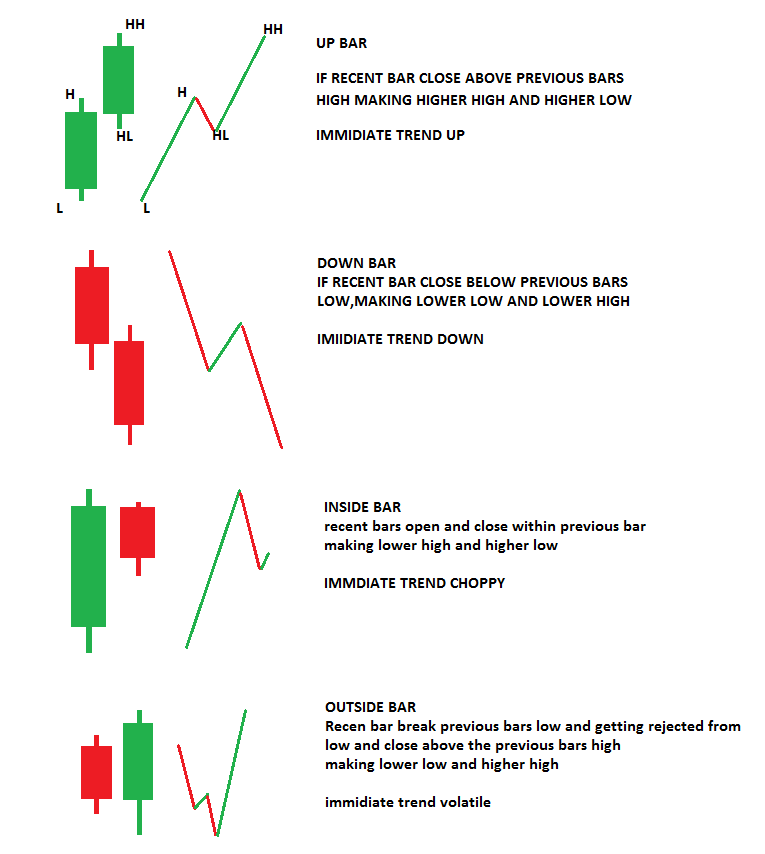
- An up bar starts an upswing and confirms the end of a downswing
- A down bar starts a downswing and confirms the end of an upswing
- The inside bar does not break the previous high low; they do not affect the direction of the current swing
- The outside bar breaks both the previous high and low, introducing uncertainty in the market structure. The outside bar in the upswing cont the upswing, and the outside bar in the downswing cont the downswing. Typically, an outside bar does not end or start a price swing without a down bar or a break below the swing low; an upswing will cont
DIRECTION OF TREND WITH RESPECT TO CANDLE POSITION
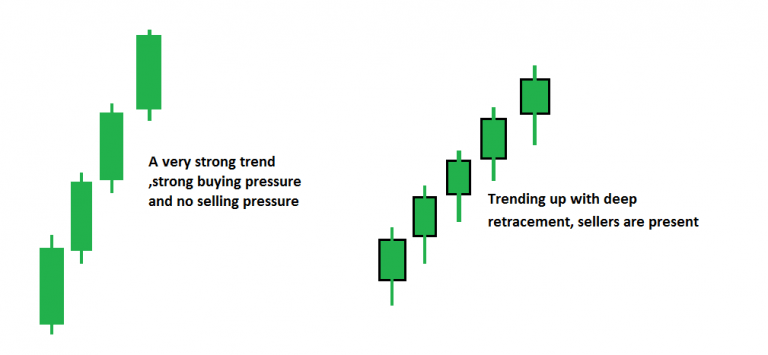


Context or Background
CANDLESTICK should not be analyzed in a vacuum. A candlestick must always be analyzed in the context of what has happened in the past.
Context is what the current candlestick shows with respect to the previous candlestick.
- Is the current candlestick larger or smaller than the previous ones? Which shows momentum increases or decreases
- Is the size changing meaningfully or not? Buying or selling pressure
- Does volatility increase or decrease
- Is the change happening during an active trading period or not? For example, candlesticks in mid-period are generally dead or inactive.

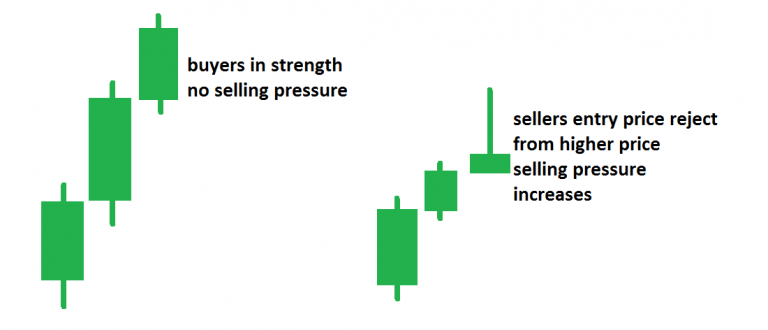
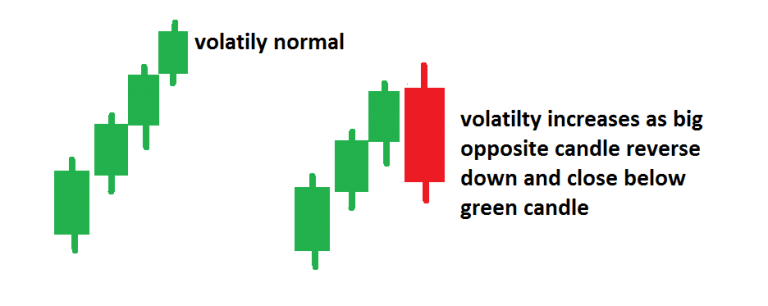
TESTING PRICE LEVELS
Testing refers to the market moving towards a price level to “test” if the price level will accept or reject the market’s advances. The high and low of each price bar are natural support and resistance levels, and the wick generally acts as a supply and demand zone. The test of these levels or zones shows the undercurrents of the market and is critical for reading price action.
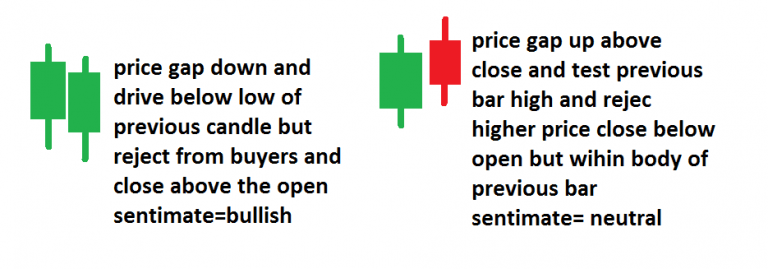

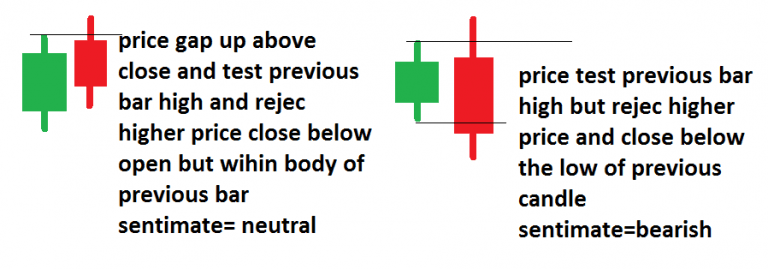
THREE PRICE BARS/expectation
With a clear read of 2 BAR PRICE ACTION (DIRECTION, CONTEXT, TESTING), we can form an expectation of the market in the third candle. We expect the market to move in a certain way in the third bar with our read of 2 bar price action. The confirmation or failure of our expectations of the third bar reveals more about the market and adds to our price action analysis.
To form expectations, we need to make a very simple assumption about how the market should behave and should not behave. Essentially, the market has momentum and inertia. bearishness should follow bearishness, and bullishness should follow bullishness. When it does not obey this assumption, we have to be cautious. There may be a change in market direction.
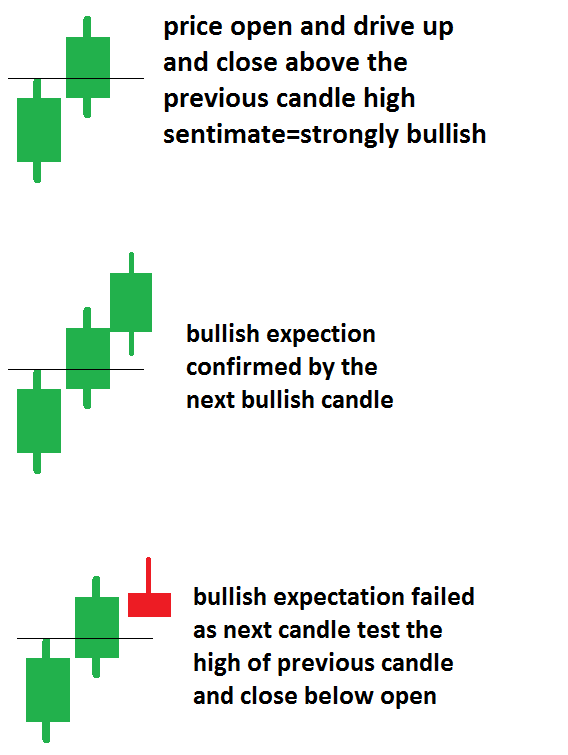
Some more examples
